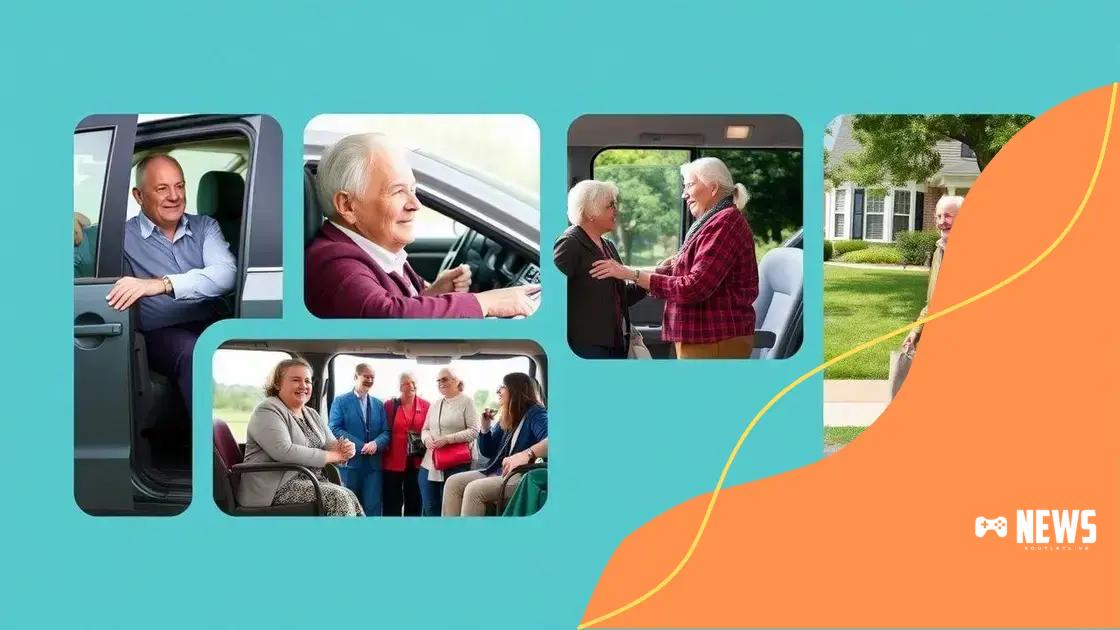Transportation assistance for seniors: enhancing independence

Transportation assistance for seniors enhances their independence by providing access to essential services and social activities, utilizing technology to streamline processes and improve safety and convenience.
Transportation assistance for seniors plays a crucial role in their daily lives, helping them maintain independence and stay active. Have you ever thought about how this impacts their everyday activities? Let’s explore this essential support.
Understanding the needs of seniors in transportation
Understanding the needs of seniors in transportation is essential for enhancing their daily lives. As people age, their mobility often decreases, making reliable transportation even more crucial. Many seniors face challenges that can limit their ability to travel independently, and addressing these needs can improve their quality of life.
Key Factors Influencing Senior Transportation Needs
Several factors directly affect how seniors navigate transportation options. For instance, physical limitations such as reduced strength or mobility can hinder their ability to drive or use public transit. Additionally, cognitive changes may make it more challenging for them to plan trips or remember routes. Understanding these factors helps caregivers and service providers better assist seniors.
- Physical limitations and mobility issues
- Cognitive changes impacting navigation and planning
- Accessibility of public transportation options
- Safety concerns for senior travelers
Moreover, social needs play a significant role in transportation for seniors. Many enjoy outings that allow them to connect with friends and family. Lack of transportation can lead to social isolation, which may adversely affect mental health. Ensuring seniors can participate in social activities is vital for their well-being.
Common Transportation Challenges
Recognizing the common transportation challenges can help tailor solutions. Transportation issues may arise from a lack of available services in their area. Often, seniors who no longer drive have limited options for medical appointments, grocery shopping, or social events. It’s essential to explore transportation options that alleviate these challenges.
- Limited access to reliable transportation services
- Difficulty in booking rides and knowing their options
- High costs associated with transportation services
By understanding the unique needs of seniors in transportation, we can better advocate for solutions that promote independence and well-being. Engaging with seniors about their preferences and concerns can create a more supportive environment.
Types of transportation assistance available
There are several types of transportation assistance available to meet the diverse needs of seniors. Each option offers unique benefits and can be tailored to individual preferences. Understanding these options is key to enhancing mobility and independence for seniors.
Public Transportation Services
Public transport often provides a cost-effective solution for seniors. Many cities offer reduced fares for seniors, making it easier for them to access essential services. Although public transportation can be a great option, it sometimes lacks accessibility features.
- Bus and subway services with senior discounts
- Accessible vehicles designed for wheelchairs
- Senior-friendly schedules with fewer crowds
For those who prefer more direct routes, shuttle services are another alternative. Shuttles often cater specifically to seniors, ensuring comfortable and safe travel.
Private Transportation Options
There are also private transportation options available, such as ride-sharing services tailored for seniors. These services offer door-to-door assistance which can be especially beneficial for those with mobility challenges. However, understanding how to use these technologies is essential for many seniors.
- Ride-sharing apps with senior-friendly interfaces
- Taxi services specifically for seniors
- Local private shuttles for community events
In addition to these services, volunteer driver programs are available in many communities. Volunteers often provide free rides to seniors for essential appointments, which fosters community support.
Specialized Transportation Programs
Some organizations offer specialized programs that cater to the unique needs of seniors. These programs may include non-emergency medical transportation (NEMT), ensuring seniors can attend medical appointments without the stress of navigating public transportation.
- Transportation for medical visits
- Arrangements for grocery shopping
- Transportation for social events and activities
By utilizing these various types of transportation assistance, seniors can explore their communities, stay active, and maintain their independence. Organizations and family members can play vital roles in helping seniors navigate their transportation options, ensuring they remain engaged and connected.
How transportation helps maintain seniors’ independence

Transportation plays a crucial role in maintaining seniors’ independence. When seniors have access to reliable transportation, they can engage more freely in daily activities. This access promotes their ability to make choices about when and where to go, enhancing their quality of life.
Encouraging Social Engagement
With transportation options available, seniors can attend community events, visit friends and family, and participate in social gatherings. These interactions are vital for their mental and emotional health. Strong social connections can prevent feelings of loneliness and isolation.
- Regular visits with family and friends
- Attendance at community events and activities
- Participation in hobby groups and clubs
Being active in their communities not only keeps seniors socially connected but also helps them stay informed about local events and resources.
Access to Essential Services
Transportation assistance also ensures that seniors can reach essential services such as medical appointments, grocery stores, and pharmacies. Regular access to healthcare is essential for managing chronic conditions and maintaining overall health. When seniors can visit their doctors and access medications without hassle, they are more likely to take control of their health.
- Consistent visits to healthcare providers
- Easy access to grocery stores for nutritious food
- Transportation for personal errands and shopping
This access directly contributes to their independence, allowing them to make decisions regarding their health and wellbeing.
Boosting Confidence and Independence
Having reliable transportation boosts seniors’ confidence. When they know they can get where they need to go, they feel empowered to venture out on their own. This independence is critical for their self-esteem and overall happiness. When seniors feel capable of managing their travel needs, they often lead more fulfilling lives.
Transportation not only facilitates mobility; it also fosters a sense of autonomy. It allows seniors to maintain control over their lives, reaffirming their identity and role in their community. The ability to travel freely supports their desire to live independently and reduces reliance on family members or caregivers.
Tips for choosing transportation services for elders
Choosing the right transportation services for elders can significantly enhance their mobility and independence. It is essential to consider their specific needs and preferences to ensure a smooth experience.
Assessing Individual Needs
Every senior’s situation is unique, so start by assessing their specific transportation needs. Consider factors such as mobility level, health conditions, and preferred travel times. Understanding these elements will guide the selection of the best service.
- How easily can they get in and out of a vehicle?
- Are there any health concerns that require special accommodations?
- Do they prefer fixed schedules or more flexible options?
Open communication with the senior is vital. Ask them about their comfort levels with different types of transportation, whether they feel safe and are aware of their options.
Checking Accessibility Features
When evaluating transportation services, accessibility features should be at the forefront of your considerations. Ensuring that vehicles are equipped to meet the needs of seniors will provide peace of mind. Make sure the service offers vehicles with wheelchair access or other necessary modifications.
- Wheelchair ramps or lifts for easy access
- Support for guide dogs or mobility devices
- Trained drivers who can assist seniors
These factors are crucial to ensure that seniors can travel comfortably and safely.
Reviewing Service Providers
Before deciding on a transportation service, it is essential to do some research. Look for reviews and testimonials from other users. These insights can reveal important information about reliability, timeliness, and the overall quality of service.
Ask questions regarding pricing, booking procedures, and any cancellation policies. Some services may offer discounts for seniors or loyalty programs, which could be beneficial.
Trial Runs
If possible, arrange for trial runs with potential service providers. This trial period allows seniors to experience the service firsthand. It can help them feel more comfortable and give you a better understanding of how well the service meets their needs.
Taking the time to carefully choose transportation services can make a positive impact on a senior’s life. It promotes independence, enhances their quality of life, and fosters connections within their community.
The role of technology in aiding transportation for seniors
The role of technology in aiding transportation for seniors has become increasingly important. With the advancement of smart devices and applications, seniors can access transportation options more easily than ever before. This technology helps bridge the gap between mobility and independence.
Transportation Apps
Many transportation services now offer user-friendly apps designed specifically for seniors. These apps can simplify the process of booking rides. Seniors can easily schedule pickups and receive notifications about their rides without having to call a service directly.
- Easy-to-navigate interfaces tailored for seniors
- Options for scheduling rides in advance
- Real-time tracking of vehicles for added safety
Using these apps empowers seniors by giving them control over their travel plans, making it easier for them to connect with friends, family, and services.
Wearable Technology
Wearable devices are another technological advancement that enhances seniors’ transportation experience. Many wearables now include features such as emergency alerts or GPS tracking, giving both seniors and their families peace of mind as they travel.
- Emergency buttons for quick assistance
- GPS tracking to ensure safety
- Health monitoring features that can alert caregivers
These technologies not only improve safety but also provide reassurance for both seniors and those who care for them.
Smart Vehicle Features
Modern vehicles also come equipped with smart technology that supports senior drivers. Features like adaptive cruise control, lane-keeping assistance, and automatic braking enhance road safety, making it easier for seniors to drive comfortably.
For seniors who may be hesitant to drive, smart technology can enhance their confidence behind the wheel. This added safety makes transportation easier for seniors who prefer to maintain their independence while driving.
Accessibility and Information Sharing
Technology can also aid in providing essential information about transportation options. Websites and apps that offer comparisons of local transportation services make it simple for seniors to find accessible options.
By sharing information about transportation resources, seniors can make informed decisions that best suit their needs. The integration of technology in transportation not only aids mobility but enriches the lives of seniors.
FAQ – Frequently Asked Questions about Transportation Assistance for Seniors
What are the main types of transportation services available for seniors?
Seniors can utilize public transportation, private ride-sharing services, volunteer driver programs, and specialized transportation options for medical visits and errands.
How can technology help seniors with transportation?
Technology can provide user-friendly apps for booking rides, wearable devices for safety, and smart vehicle features that enhance driving experiences.
What should I consider when choosing transportation services for seniors?
It’s important to assess individual needs, check for accessibility features, review service providers, and consider trial runs to ensure comfort and safety.
How does reliable transportation impact seniors’ independence?
Reliable transportation enables seniors to maintain their social connections, access essential services, and participate in community activities, all of which enhance their independence.





